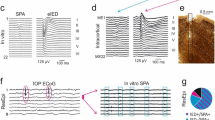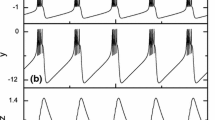…in the hippocampal formation and septum, clear behavioral correlates
can be determined for almost all neurons…
Ranck, 1973
Abstract
The majority of neurons in lateral septum (LS) are electrically silent at resting membrane potential. Nicotine transiently excites a subset of neurons and occasionally leads to long lasting bursting activity upon longer applications. We have observed simultaneous changes in frequencies and amplitudes of spontaneous action potentials (AP) in the presence of nicotine. During the prolonged exposure, nicotine increased numbers of spikes within a burst. One of the hallmarks of nicotine effects was the occurrences of double spikes (known also as bursting). Alignment of 51 spontaneous spikes, triggered upon continuous application of nicotine, revealed that the slope of after-depolarizing potential gradually increased (1.4 vs. 3 mV/ms) and neuron fired the second AP, termed as double spiking. A transition from a single AP to double spikes increased the amplitude of after-hyperpolarizing potential. The amplitude of the second (premature) AP was smaller compared to the first one, and this correlation persisted in regard to their duration (half-width). A similar bursting activity in the presence of nicotine, to our knowledge, has not been reported previously in the septal structure in general and in LS in particular.












Similar content being viewed by others
Abbreviations
- LS:
-
Lateral septum
- HCN:
-
Hyperpolarization-activated cyclic nucleotide gated non-selective cation channels
- RTP:
-
Rebound tail potential
- nAChRs:
-
Nicotinic acetylcholine receptors
References
Adams BEL, Reid CA, Myers D, Ng C, Powell K, Phillips AM, Zheng T, O’Brien TJ, Williams DA (2009) Excitotoxic-mediated transcriptional decreases in HCN2 channel function increase network excitability in CA1. Exp Neurol 219:249–257
Angelo K, Margrie TW (2011) Population diversity and function of hyperpolarization-activated current in olfactory bulb mitral cells. Sci Rep 1:50
Arimitsu T, Nuriya M, Ikeda K, Takahashi T, Yasui M (2009) Activity-dependent regulation of HCN1 protein in cortical neurons. Biochem Biophys Res Commun 387:87–91
Bancila V, Cordeiro JM, Bloc A, Dunant Y (2009) Nicotine-induced and depolarisation-induced glutamate release from hippocampus mossy fibre synaptosomes: two distinct mechanisms. J Neurochem 110:570–580
Bender RA, Galindo R, Mameli M, Gonzalez-Vega R, Valenzuela CF, Baram TZ (2005) Synchronized network activity in developing rat hippocampus involves regional hyperpolarization-activated cyclic nucleotide-gated (HCN) channel function. Eur J Neurosci 22:2669–2674
Blethyn KL, Hughes SW, Toth TI, Cope DW, Crunelli V (2006) Neuronal basis of the slow (<1 Hz) oscillation in neurons of the nucleus reticularis thalami in vitro. J Neurosci 26:2474–2486
Brager DH, Lewis AS, Chetkovich DM, Johnston D (2013) Short- and long-term plasticity in CA1 neurons from mice lacking h-channel auxiliary subunit TRIP8b. J Neurophysiol 110:2350–2357
Brauer AU, Savaskan NE, Kole MHP, Plaschke M, Monteggia LM, Nestler EJ, Simburger EVA, Deisz RA, Ninnemann O, Nitsch R (2001) Molecular and functional analysis of hyperpolarization-activated pacemaker channels in the hippocampus after entorhinal cortex lesion. FASEB J 15:2689–2701
Campanac E, Hoffman DA (2013) Repeated cocaine exposure increases fast-spiking interneuron excitability in the rat medial prefrontal cortex. J Neurophysiol 109:2781–2792
Carette B (1999) Noradrenergic responses of neurones in the mediolateral part of the lateral septum: α1-adrenergic depolarization and rhythmic bursting activities, and α2-adrenergic hyperpolarization from guinea pig brain slices. Brain Res Bull 48:263–276
Changeux JP (2009) Nicotinic receptors and nicotine addiction. C R Biol 332:421–425
Cisse RS, Krebs-Kraft DL, Parent MB (2008) Septal infusions of the hyperpolarization-activated cyclic nucleotide-gated channel (HCN-channel) blocker ZD7288 impair spontaneous alternation but not inhibitory avoidance. Behav Neurosci 122:549–556
D’Agostino M, Crespi A, Polishchuk E, Generoso S, Martire G, Colombo S, Bonatti S (2014) ER reorganization is remarkably induced in COS-7 cells accumulating transmembrane protein receptors not competent for export from the endoplasmic reticulum. J Membr Biol 247:1149–1159
Day M, Carr DB, Ulrich S, Ilijic E, Tkatch T, Surmeier DJ (2005) Dendritic excitability of mouse frontal cortex pyramidal neurons is shaped by the interaction among HCN, Kir2, and Kleak channels. J Neurosci 25:8776–8787
Dibattista M, Mazzatenta A, Grassi F, Tirindelli R, Menini A (2008) Hyperpolarization-activated cyclic nucleotide-gated channels in mouse vomeronasal sensory neurons. J Neurophysiol 100:576–586
DiFrancesco D, Porciatti F, Janigro D, Maccaferri G, Mangoni M, Tritella T, Chang F, Cohen IS (1991) Block of the cardiac pacemaker current (If) in the rabbit sino-atrial node and in canine Purkinje fibres by 9-amino-1,2,3,4-tetrahydroacridine. Pflugers Arch 417:611–615
Fisher JL, Dani JA (2000) Nicotinic receptors on hippocampal cultures can increase synaptic glutamate currents while decreasing the NMDA-receptor component. Neuropharmacology 39:2756–2769
Freund TF, Antal M (1988) GABA-containing neurons in the septum control inhibitory interneurons in the hippocampus. Nature 336:170–173
Görlich A, Antolin-Fontes B, Ables JL, Frahm S, Slimak MA, Dougherty JD, Ibañez-Tallon I (2013) Reexposure to nicotine during withdrawal increases the pacemaking activity of cholinergic habenular neurons. Proc Natl Acad Sci USA 110:17077–17082
Hamill OP, Marty A, Neher E, Sakmann B, Sigworth FJ (1981) Improved patch-clamp techniques for high-resolution current recording from cells and cell-free membrane patches. Pflugers Arch 391:85–100
Hangya B, Borhegyi Z, Szilagyi N, Freund TF, Varga V (2009) GABAergic neurons of the medial septum lead the hippocampal network during theta activity. J Neurosci 29:8094–8102
Klaassen A, Glykys J, Maguire J, Labarca C, Mody I, Boulter J (2006) Seizures and enhanced cortical GABAergic inhibition in two mouse models of human autosomal dominant nocturnal frontal lobe epilepsy. Proc Natl Acad Sci USA 103:19152–19157
Koch U, Grothe B (2003) Hyperpolarization-activated current (I h) in the inferior colliculus: distribution and contribution to temporal processing. J Neurophysiol 90:3679–3687
Kodirov SA (2015) Targets of addictive nicotine in neurons and different regions of the CNS—amygdala, cerebellum, cortex, hippocampus, hypothalamus, raphe nucleus, septum, striatum, brainstem, and spinal cord—and interactions with alcohol. In: Preedy VP (ed) The neuropathology of drug addictions and substance misuse. Elsevier, London
Kodirov SA, Takizawa S, Joseph J, Kandel ER, Shumyatsky GP, Bolshakov VY (2006) Synaptically released zinc gates long-term potentiation in fear conditioning pathways. Proc Natl Acad Sci USA 103:15218–15223
Kodirov SA, Jasiewicz J, Amirmahani P, Psyrakis D, Bonni K, Wehrmeister M, Lutz B (2010) Endogenous cannabinoids trigger the depolarization-induced suppression of excitation in the lateral amygdala. Learn Mem 17:832–838
Kodirov SA, Wehrmeister M, Colom LV (2014) Modulation of HCN channels in lateral septum by nicotine. Neuropharmacology 81:274–282
Kolaj M, Zhang L, Renaud LP (2014) Novel coupling between TRPC-like and KNa channels modulates low threshold spike-induced after potentials in rat thalamic midline neurons. Neuropharmacology 86:88–96
Kononenko NI, Berezetskaya NM (2010) Modeling the spontaneous activity in suprachiasmatic nucleus neurons: role of cation single channels. J Theor Biol 265:115–125
Krishtal O (2015) Receptor for protons: first observations on acid sensing ion channels. Neuropharmacology 94:4–8
Lewis AS, Vaidya SP, Blaiss CA, Liu Z, Stoub TR, Brager DH, Chen X, Bender RA, Estep CM, Popov AB, Kang CE, Van Veldhoven PP, Bayliss DA, Nicholson DA, Powell CM, Johnston D, Chetkovich DM (2011) Deletion of the hyperpolarization-activated cyclic nucleotide-gated channel auxiliary subunit TRIP8b impairs hippocampal I h localization and function and promotes antidepressant behavior in mice. J Neurosci 31:7424–7440
Luthi A, McCormick DA (1998) H-current: properties of a neuronal and network pacemaker. Neuron 21:9–12
Magee JC (1999) Dendritic l h normalizes temporal summation in hippocampal CA1 neurons. Nat Neurosci 2:508–514
Mameli-Engvall M, Evrard A, Sp Pons, Maskos U, Svensson TH, Changeux J-P, Faure P (2006) Hierarchical control of dopamine neuron-firing patterns by nicotinic receptors. Neuron 50:911–921
Mao B-Q, MacLeish PR, Victor JD (2003) Role of hyperpolarization-activated currents for the intrinsic dynamics of isolated retinal neurons. Biophys J 84:2756–2767
Marcelin B, Chauviere L, Becker A, Migliore M, Esclapez M, Bernard C (2009) h channel-dependent deficit of theta oscillation resonance and phase shift in temporal lobe epilepsy. Neurobiol Dis 33:436–447
Matsuo R, Kobayashi S, Wakiya K, Yamagishi M, Fukuoka M, Ito E (2014) The cholinergic system in the olfactory center of the terrestrial slug Limax. J Comp Neurol 522:2951–2966
McRae-Degueurce A, Booj S, Haglid K, Rosengren L, Karlsson JE, Karlsson I, Wallin A, Svennerholm L, Gottfries CG, Dahlstrom A (1987) Antibodies in cerebrospinal fluid of some Alzheimer disease patients recognize cholinergic neurons in the rat central nervous system. Proc Nat Acad Sci USA 84:9214–9218
Nazzari H, Angoli D, Chow SS, Whitaker G, Leclair L, McDonald E, Macri V, Zahynacz K, Walker V, Accili EA (2008) Regulation of cell surface expression of functional pacemaker channels by a motif in the B-helix of the cyclic nucleotide-binding domain. Am J Physiol Cell Physiol 295:C642–C652
Noble D, Tsien RW (1968) The kinetics and rectifier properties of the slow potassium current in cardiac Purkinje fibres. J Physiol 195:185–214
Pal B, Por A, Szucs G, Kovacs I, Rusznak Z (2003) HCN channels contribute to the intrinsic activity of cochlear pyramidal cells. Cell Mol Life Sci 60:2189–2199
Ponterio G, Tassone A, Sciamanna G, Riahi E, Vanni V, Bonsi P, Pisani A (2013) Powerful inhibitory action of mu opioid receptors (MOR) on cholinergic interneuron excitability in the dorsal striatum. Neuropharmacology 75:78–85
Porter JT, Cauli B, Tsuzuki K, Lambolez B, Rossier J, Audinat E (1999) Selective excitation of subtypes of neocortical interneurons by nicotinic receptors. J Neurosci 19:5228–5235
Racine RJ, Milgram NW, Hafner S (1983) Long-term potentiation phenomena in the rat limbic forebrain. Brain Res 260:217–231
Ranck JB Jr (1973) Studies on single neurons in dorsal hippocampal formation and septum in unrestrained rats: part I. Behavioral correlates and firing repertoires. Exp Neurol 41:462–531
Rozario AO, Turbendian HK, Fogle KJ, Olivier NB, Tibbs GR (2009) Voltage-dependent opening of HCN channels: facilitation or inhibition by the phytoestrogen, genistein, is determined by the activation status of the cyclic nucleotide gating ring. Biochim Biophys Acta 1788:1939–1949
Solomon JS, Doyle JF, Burkhalter A, Nerbonne JM (1993) Differential expression of hyperpolarization-activated currents reveals distinct classes of visual cortical projection neurons. J Neurosci 13:5082–5091
Thomas E, Burock D, Knudsen K, Deterding E, Yadin E (2013) Single unit activity in the lateral septum and central nucleus of the amygdala in the elevated plus-maze: a model of exposure therapy? Neurosci Lett 548:269–274
Thon S, Schmauder R, Benndorf K (2014) Elementary functional properties of single HCN2 channels. Biophys J 105:1581–1589
Thuault SJ, Malleret G, Constantinople CM, Nicholls R, Chen I, Zhu J, Panteleyev A, Vronskaya S, Nolan MF, Bruno R, Siegelbaum SA, Kandel ER (2013) Prefrontal cortex HCN1 channels enable intrinsic persistent neural firing and executive memory function. J Neurosci 33:13583–13599
Tokay T, Rohde M, Krabbe S, Rehberg M, Bender RA, Kohling R, Kirschstein T (2009) HCN1 channels constrain DHPG-induced LTD at hippocampal Schaffer collateral-CA1 synapses. Learn Mem 16:769–776
Toth K, Freund TF, Miles R (1997) Disinhibition of rat hippocampal pyramidal cells by GABAergic afferents from the septum. J Physiol 500:463–474
van den Hooff P, Urban IJ, de Wied D (1989) Vasopressin maintains long-term potentiation in rat lateral septum slices. Brain Res 505:181–186
van Welie I, Wadman WJ, van Hooft JA (2005) Low affinity block of native and cloned hyperpolarization-activated I h channels by Ba2+ ions. Eur J Pharmacol 507:15–20
Vasilyev DV, Shan Q, Lee Y, Mayer SC, Bowlby MR, Strassle BW, Kaftan EJ, Rogers KE, Dunlop J (2007) Direct inhibition of I h by analgesic loperamide in rat DRG neurons. J Neurophysiol 97:3713–3721
Vassalle M, Yu H, Cohen IS (1995) The pacemaker current in cardiac Purkinje myocytes. J Gen Physiol 106:559–578
Velumian AA, Zhang L, Pennefather P, Carlen PL (1997) Reversible inhibition of I K, I AHP, I h and I Ca currents by internally applied gluconate in rat hippocampal pyramidal neurones. Pflugers Arch 433:343–350
Vinogradova OS (2001) Hippocampus as comparator: role of the two input and two output systems of the hippocampus in selection and registration of information. Hippocampus 11:578–598
Acknowledgments
The outlined research was supported by National Institute of Health. All authors appreciate the animal care and rats provided by Jennifer Bagley. We thank Boris Ermolinsky for discussions in regard to presented results and tested ideas, Raul Consunji for careful reading, and Morris Benveniste for critiques on the first draft of manuscript. Rosa Marie Pearson enthusiastically co-participated during several experiments.
Author information
Authors and Affiliations
Corresponding author
Rights and permissions
About this article
Cite this article
Kodirov, S.A., Wehrmeister, M. & Colom, L. Nicotine-Mediated ADP to Spike Transition: Double Spiking in Septal Neurons. J Membrane Biol 249, 107–118 (2016). https://doi.org/10.1007/s00232-015-9853-2
Received:
Accepted:
Published:
Issue Date:
DOI: https://doi.org/10.1007/s00232-015-9853-2




